image:
The dataset proposed by the researchers captures badminton players’ movements and responses, aiding AI-driven coaching assistants to improve stroke quality for all skill levels.
view more
Credit: SeungJun Kim at Gwangju Institute of Science and Technology (GIST)
In sports training, practice is the key, but being able to emulate the techniques of professional athletes can take a player’s performance to the next level. AI-based personalized sports coaching assistants can make this a reality by utilizing published datasets. With cameras and sensors strategically placed on the athlete’s body, these systems can track everything, including joint movement patterns, muscle activation levels, and gaze movements.
Using this data, personalized feedback is provided on player technique, along with improvement recommendations. Athletes can access this feedback anytime, and anywhere, making these systems versatile for athletes at all levels.
Now, in a study published in the journal Scientific Data on April 5, 2024, researchers led by Associate Professor SeungJun Kim from the Gwangju Institute of Science and Technology (GIST), South Korea, in collaboration with researchers from Massachusetts Institute of Technology (MIT), CSAIL, USA, have developed a MultiSenseBadminton dataset for AI-driven badminton training.
“Badminton could benefit from these various sensors, but there is a scarcity of comprehensive badminton action datasets for analysis and training feedback,” says Ph.D. candidate Minwoo Seong, the first author of the study.
Supported by the 2024 GIST-MIT project, this study took inspiration from MIT’s ActionSense project, which used wearable sensors to track everyday kitchen tasks such as peeling, slicing vegetables, and opening jars. Seong collaborated with MIT’s team, including MIT CSAIL postdoc researcher Joseph DelPreto and MIT CSAIL Director and MIT EECS Professor Daniela Rus and Wojciech Matusik. Together, they developed the MultiSenseBadminton dataset, capturing movements and physiological responses of badminton players. This dataset, shaped with insights from professional badminton coaches, aims to enhance the quality of forehand clear and backhand drive strokes. For this, the researchers collected 23 hours of swing motion data from 25 players with varying levels of training experience.
During the study, players were tasked with repeatedly executing forehand clear and backhand drive shots while sensors recorded their movements and responses. These included inertial measurement units (IMU) sensors to track joint movements, electromyography (EMG) sensors to monitor muscle signals, insole sensors for foot pressure, and a camera to record both body movements and shuttlecock positions. With a total of 7,763 data points collected, each swing was meticulously labeled based on stroke type, player’s skill level, shuttlecock landing position, impact location relative to the player, and sound upon impact. The dataset was then validated using a machine learning model, ensuring its suitability for training AI models to evaluate stroke quality and offer feedback.
“The MultiSenseBadminton dataset can be used to build AI-based education and training systems for racket sports players. By analyzing the disparities in motion and sensor data among different levels of players and creating AI-generated action trajectories, the dataset can be applied to personalized motion guides for each level of players,” says Seong.
The gathered data can enhance training through haptic vibration or electrical muscle stimulation, promoting better motion and refining swing techniques. Additionally, player tracking data, like that in the MultiSenseBadminton dataset, could fuel virtual reality games or training simulations, making sports training more accessible and affordable, potentially transforming how people exercise.
In the long run, the researchers speculate that this dataset could make sports training more accessible and affordable for a broader audience, promote overall well-being, and foster a healthier population.
***
Reference
DOI: https://doi.org/10.1038/s41597-024-03144-z
About Gwangju Institute of Science and Technology (GIST)
The Gwangju Institute of Science and Technology (GIST) was founded in 1993 by the Korean government as a research-oriented graduate school to help ensure Korea’s continued economic growth and prosperity by developing advanced science and technology with an emphasis on collaboration with the international community. Since that time, GIST has pioneered a highly regarded undergraduate science curriculum in 2010 that has become a model for other science universities in Korea. To learn more about GIST and its exciting opportunities for researchers and students alike, please visit: http://www.gist.ac.kr/.
About the authors
SeungJun Kim is an Associate Professor at the Gwangju Institute of Science and Technology (GIST), overseeing the human-centered intelligent systems laboratory. Previously, he served as a special faculty at the Human-Computer Interaction Institute, Carnegie Mellon University, leading research in XR, robotics, and human-AI interaction. Dr. Kim holds a B.S. in Electrical Engineering from KAIST and an M.S. and Ph.D. in Mechatronics from GIST. His research focuses on sensory intelligence and augmentation through multimodal XR in ubiquitous computing environments, recognized with paper awards from UbiComp, IEEE ISMAR, and ACM AutoUI.
Minwoo Seong is an applied AI researcher and specializes in sensory reconstruction of human motions in real and virtual worlds. Seong holds a B.S. in Mechanical Engineering and an M.S. in Robotics from Gwangju Institute of Science and Technology (GIST), from where he is currently pursuing his Ph.D. Seong’s work has earned recognition, including the Best Paper Award from KCC and a runner-up award at the IJCAI 2023.
Method of Research
Data/statistical analysis
Subject of Research
People
Article Title
MultiSenseBadminton: Wearable Sensor–Based Biomechanical Dataset for Evaluation of Badminton Performance
Article Publication Date
5-Apr-2024
COI Statement
The authors declare no competing interests.
Disclaimer: AAAS and EurekAlert! are not responsible for the accuracy of news releases posted to EurekAlert! by contributing institutions or for the use of any information through the EurekAlert system.

